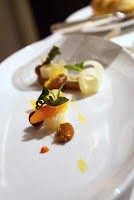Avoiding the dreaded ‘C word’ around this time of year is
getting harder and harder. Turkey recipes are popping up everywhere and we even
did our first turkey dinner function at the hotel last week (its bloody
November for crying out loud!). I should probably try and insert a “Humbug”
around here somewhere but truth be told I am not anti-C****mas; I just think
that November has a lot more to offer than Turkey anticipation. That said I would love to have a crack at a whole
deep fried turkey – see the video here!
Autumn and early winter is all about game for me, its
many feathered and furred varieties are reasons enough to celebrate the season.
We have a beautiful venison dish on in the restaurant at the moment that combines
a slow braised haunch with a loin cooked medium rare and a sloe gin honey (the
smell of which when warmed through is amazing).
At home I have been experimenting with rabbit, venison,
pheasant and pigeon. While venison often has a luxury price tag, a whole rabbit,
pheasant or brace of pigeon is unlikely to cost you more than a fiver and is
plenty enough to feed two generously. Nothing too adventurous or wacky here,
the main ingredient is simply seasoned, browned in a pan and finished in the
oven. Maybe chuck in some rosemary or juniper to heighten the flavours but they
are strong enough to shine through on their own. This means that you can use a
garnish with a big flavour for example a sweet and sour red cabbage or smoky
flavours as in the recipe below, even coffee and chocolate are often paired
with venison.
The red cabbage recipe below is a version of one that we
have used in the past in the restaurant, there it is cooked with the addition
of a rich Jus and so ends up truly dark, sticky and shiny. While this is
beautiful, I simply don’t have access to the huge stock pot, three day cooking
process, piles of bones, chicken wings and gallons of wine at home (sadly!).
Also, even if I did it would probably be a bit excessive for a cabbage side for
two people.
Venison with red
cabbage and smoked potato croquettes
2 individual sized pieces Venison Loin
5/6 Juniper berries
Cold butter
Salt & pepper
Crush the juniper berries with the salt and used to
season the venison. Pan fry to desired level of ‘doneness’, chuck in a couple
of knobs of the butter towards the end of cooking to baste the meat as it foams.
Check seasoning and rest well before serving
Red Cabbage
1 Red cabbage
1 Red onion
1 Apple
200ml Balsamic vinegar
200ml Red wine
3 Star anise
2 Bay leaves
Water/stock
1 jar Redcurrent jelly (you won’t use all but judge it to
taste)
Chiffonade the cabbage, red onion and apple and sweat
down in a saucepan. Turn up the heat and add the star anise and bay leaves. Then
chuck in the balsamic vinegar and let reduce a little before adding the red
wine and reducing again. Top up with stock (or water) to cover and turn down to
a simmer. Let it simmer for a good few hours (anywhere up to about seven) until
there is only a little bit of liquid left, raising the heat at the end to
reduce if you need to. At this stage you can chill the cabbage down and it will
keep for frankly ages as it is pretty much pickled. Finish by adding a good
dollop of redcurrent jelly to taste and picking out the anise and bay. The
balance of vinegar and redcurrent should give a big, sweet and sour flavour and
finishing with the jelly will make it sticky and shiny.
Smoked Potato
croquettes
2 medium sized Potatoes
A couple of sprigs of Thyme
Egg
Flour
Breadcrumbs
Barbecue smoking chips
Peel and dice the potato. Steam in a bamboo steamer above
a pan of water until cooked through and soft. When the potato is cooked take
the steamer off (leave the potato in it) and tip away the water. Dry the pan, sprinkle
in a small handful of the wood chips and put back on the heat, shaking
occasionally. When the wood starts to smoke put the steamer back on and after a
minute or so take off the heat and leave to allow the smoke to absorb for about
5 minutes.
Chop the thyme leaves and mix through the cooked potato
along with some salt and pepper, crushing it up as you go. Roll in cling film
to form a sausage approximately 2cm in diameter and chill.
When the potato is well chilled, slice into 6cm long
pieces(ish... make them as big as you want, it’s your dinner after all). Dip
first in flour, then egg then breadcrumbs to completely coat and then deep fry
at 180C for about 4 minutes.
Roast Pheasant
with pheasant sausage and game chips
1 Pheasant
1 Pork sausage (get a decent sausage from your local
butcher but go for a plain pork one)
100g Black pudding
2 Onions
1 Carrot
3 sticks celery
1 leek
1 parsnip
500ml red wine
Prep the pheasant and make stock:
Take the legs and thighs off the pheasant, debone them
and dice the meat. Take the breasts off on the bone in one piece; trim the wing
bone down for presentation. Strip off any remaining bits of meat and reserve. Roast the carcass along with the leg bones for
about 30mins at 160C. In the meantime brown off 1 onion, celery, carrot and leek
in a stockpot. Put in the roasted carcass and deglaze with ½ the wine. Top up
with water and simmer gently for as long as you have (put it on the night
before if you can). Pass through a fine sieve and reduce by a ½ and set aside.
Pheasant sausage:
Take the sausage meat out of the skin and mix well with ¾
of the chopped leg meat and chopped black pudding. Cook a small piece and check
for seasoning. Roll into balls or into sausage shapes and chill.
Game chips:
Peel the parsnip then use the peeler to slice it along
the length. Deep fry until golden brown, drain on kitchen paper and salt.
To finish – colour the pheasant breasts in a hot pan and
then roast in a hot oven for 15-20mins or until done. Fry off the sausages and
finish in the oven. Colour the meat off cuts and the remaining ¼ leg meat and
the other onion, chopped. Stir in a tablespoon of flour and cook for a couple
of minutes. Deglaze with the rest of the wine, reduce by 2/3 and then add hot
stock until you are happy with the consistency and colour of the sauce. Take
the breasts off the bone to serve and top with the game chips, serving with the
sausages and sauce (plus some veggies and stuff obviously, maybe roast
potatoes, a celeriac or carrot puree or whatever you fancy really).

























































